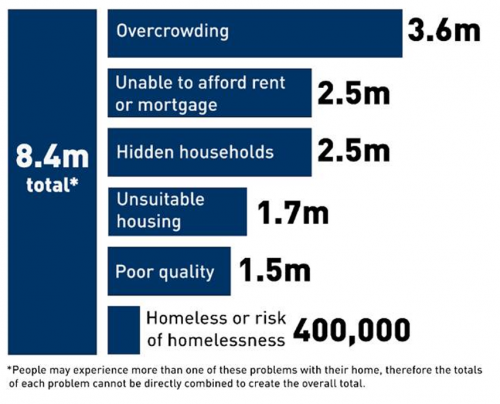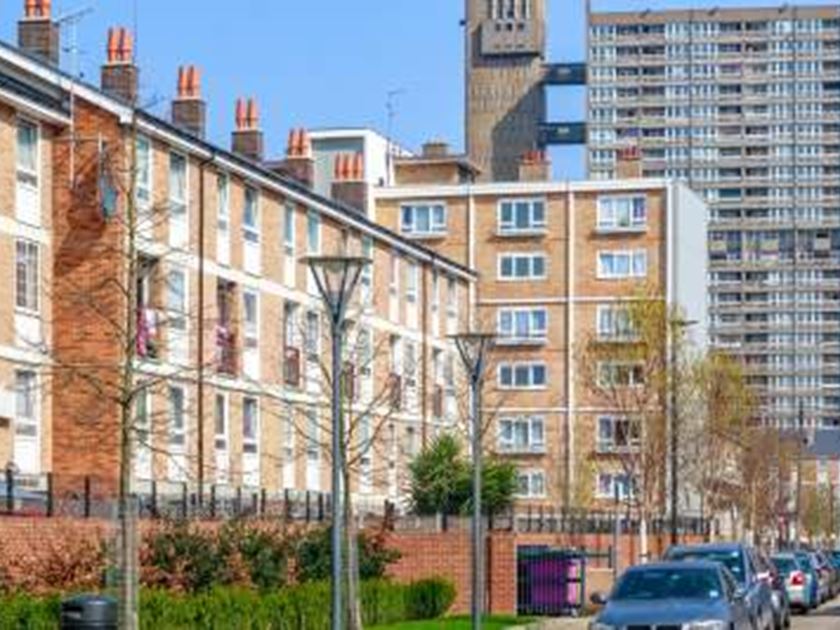More than 8m people in England – around 1 in 7 – are living in an unaffordable, insecure or unsuitable home, according to the first ever ‘state of the nation’ report on the housing crisis, released today by the National Housing Federation.(i)
The research shows that 8.4m people are hit by the broken housing market, capturing the true breadth, scale and impact of the housing crisis for the first time. It also shows that the crisis affects people of all generations and in all parts of the country. They face a wide range of issues, from homelessness and serious debt to overcrowding and ill health, and many children are missing out on a fair start in life.
For the first time, the research captures exactly how many people are hit by different aspects of the housing crisis, including high house prices and rents, unsuitable or poor quality homes, and the overall shortage of new homes. It reveals that more than 3.6m people are living in overcrowded homes, while 2.5m people can’t afford their rent or mortgage. Another 2.5m adults are stuck living with parents, with an ex-partner, or with friends because they can’t afford to move out.
The research also shows how the housing crisis is spread across the country. More people in the North of England struggle to afford their rent, while people in the South are more likely to face overcrowding or living with their parents because they can’t afford to move out.
The research also looks at what it would take to properly house these 8.4m people. Because of this, we now know the true extent of the ‘social housing waiting list’ for the first time. Almost half (43%) can only afford to live decently if they are in social housing – 3.6m people. Social housing rents are on average 50% cheaper than from private landlords, contracts are more secure and many properties are designed specifically for older people with mobility issues.
While the Government publishes an official social housing waiting list, this is only a rough estimate of the actual need, and is known to be inaccurate and inconsistent. Today’s research shows that the actual number of people in England who need social housing (3.6m) is almost double the number on the Government’s waiting list. (ii)
To meet the housing demand revealed today, the country needs 340,000 new homes every year, including 145,000 social homes. Now, the National Housing Federation, along with Shelter, Crisis, the Campaign to Protect Rural England and the Chartered Institute of Housing, is calling on the Government to build these social homes by investing £12.8bn every year for the next decade.
This must include:
- 90,000 homes for social rent
- 30,000 homes at intermediate affordable rent
- 25,000 shared ownership homes
Kate Henderson, Chief Executive at the National Housing Federation, says:
“Today’s research reveals the full enormity of the housing crisis – clearly, it is the single biggest domestic issue we face. The Government risks losing votes if it doesn’t take action to tackle the consequences it has for the lives of young and old alike, all across the country.
“From Cornwall to Cumbria, millions of people are being pushed into debt and poverty because rent is too expensive, children can’t study because they have no space in their overcrowded homes, and many older or disabled people are struggling to move around their own home because it’s unsuitable.
“This crisis cannot be solved by tweaks around the edges of the housing market. What we need is a return to proper funding for social housing, to the levels last seen under Churchill. Investing in housing is a win-win for the Government - it would bring down the housing benefit bill, provide everyone with a secure and stable start in life, and kick start an economic boom creating thousands of jobs.”
Full breakdown of people experiencing housing problems in England (iii)

|
Type of housing problem
|
Number of people experiencing this problem in England
|
|
Living in an overcrowded home
|
3.6m
|
|
Unable to afford their rent or mortgage
|
2.5m
|
|
'Hidden households', including:
- People living in house shares or with friends who can't afford to move out
- People living with their parents (mainly young adults unable to leave their parents' home, and couples with children who've moved back in with their parents for affordability reasons or after being made homeless)
- People still living with an ex-partner, despite the relationship breaking down, because they can't afford to move out
|
2.5m
|
|
Unsuitable housing, including:
- Older people and people with physical disabilities stuck in homes they can't get around
- Families in inappropriate properties, for example those that have no outside space
|
1.7m
|
|
Poor quality homes
|
1.4m
|
|
Homeless or at risk of homelessness, including:
- People sleeping rough or in homeless shelters
- People living in temporary accomodation or sofa-surfing
- People discharged from hospital or other institutions with nowhere to go
|
400,000
|
Full regional breakdown
|
Region
|
Total number of people in need of a home
|
|
South of England
|
2.5m
|
|
North of England
|
2.2m
|
|
London
|
2.1m
|
|
Midlands
|
1.6m
|
|
Total in England
|
8.4m
|
ENDS
Notes for Editors:
The research was carried out by Heriot-Watt University for the National Housing Federation, based on earlier work commissioned by the Federation in partnership with Crisis. Figures from the Understanding Society survey were analysed to look at the scale of different types of housing need. A briefing on the research is available on request.
The homelessness figures are based on research Crisis commissioned from Heriot-Watt University. This estimates on any given night the number of households experiencing the worst forms of homelessness and those considered to be statutorily homeless or at risk of homelessness. See Chapter 5 of Crisis’s plan to end homelessness.
The National Housing Federation is the voice of affordable housing in England. We believe that everyone should have the home they need at a price they can afford. That’s why we represent the work of housing associations and campaign for better housing.
Our members provide over two and a half million homes for six million people. And each year they invest in a diverse range of neighbourhood projects that help create strong, vibrant communities.
(i) The National Housing Federation represents housing associations in England, not-for-profit landlords to more than six million people. The research was carried out by Herriot-Watt University on behalf of the National Housing Federation.
(ii) Local housing registers – often referred to as ‘waiting lists’ – are recorded at household level rather than individual. The latest national register total is 1.1m households, whereas our analysis shows a total of 2.1m households (around 3.6m people) in need of a social rented home.
(iii) People may experience more than one of these problems with their home, therefore the totals of each problem cannot be directly combined to create the overall total.











